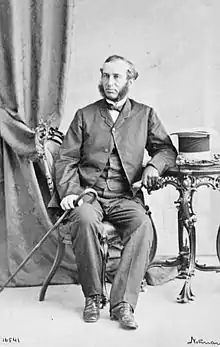Alexander Campbell (Canadian senator)
Sir Alexander Campbell KCMG PC QC (March 9, 1822 – May 24, 1892) was an English-born, Upper Canadian statesman and a father of Canadian Confederation.[2]
Sir Alexander Campbell | |
|---|---|
 | |
| Member of the Legislative Council of the Province of Canada for Cataraqui | |
| In office 1858–1867 | |
| Senator for Cataraqui, Ontario[1] | |
| In office October 23, 1867 – February 7, 1887 | |
| 6th Lieutenant Governor of Ontario | |
| In office June 1, 1887 – May 24, 1892 | |
| Monarch | Victoria |
| Governor General | The Marquess of Lansdowne The Lord Stanley of Preston |
| Premier | Oliver Mowat |
| Preceded by | John Beverley Robinson |
| Succeeded by | George Airey Kirkpatrick |
| Personal details | |
| Born | March 9, 1822 Hedon, Yorkshire, England |
| Died | May 24, 1892 (aged 70) Toronto, Ontario |
| Resting place | Cataraqui Cemetery, Kingston, Ontario |
| Nationality | Canadian |
| Political party | Conservative |
| Cabinet | Commissioner of Crown Lands (Province of Canada) (1864–1867) Postmaster General (1885–1887) Minister of Justice and Attorney General of Canada (1881–1885) Postmaster General (1880–1881) Minister of Militia and Defence (1880) Postmaster General (1879–1880) Receiver General (1878–1879) Minister of the Interior (1873) Superintendent-General of Indian Affairs (1873) Minister of Inland Revenue (Acting) (1868–1869) Postmaster General (1867–1873) |
| Signature | |
Life
Born in Hedon, Yorkshire, he was brought to Canada by his father, who was a doctor, when he was one year old. He was educated in French at St. Hyacinthe in Quebec and in the grammar school at Kingston, Ontario. Campbell studied law and was called to the bar in 1843. He became a partner in John A. Macdonald's law office.[3]
Campbell was a Freemason of St. John's Lodge, No. 3 (Ontario) of Kingston (now The Ancient St. John's No. 3). When the government was moved to Quebec in 1858, Campbell resigned.[4]
He was elected to the Legislative Council in 1858 and 1864, and served as the last Commissioner of Crown Lands 30 March 1864 – 30 June 1867. He attended the Charlottetown Conference and the Quebec City Conference in 1864, and at Confederation was appointed to the Senate of Canada. He later held a number of ministerial posts in the Cabinet of Sir John A. Macdonald and was the sixth Lieutenant Governor of Ontario from 1887 to 1892.[5]
In 1883, he built his home on Metcalfe Street, Ottawa, now known as "Campbell House".
.JPG.webp)
He died in office in Toronto in 1892, and was buried at Cataraqui Cemetery in Kingston, Ontario.[6]
Campbell Crescent in Kingston, a street in the Portsmouth municipal district, is named in his honour.
Family
In 1855, Campbell married Georgina Frederica Locke, daughter of Thomas Sandwith of Beverley, Yorkshire, and a niece of Humphrey Sandwith III (1792–1874) of Bridlington.[6] He left two sons (the eldest was Charles Sandwith Campbell) and three daughters
References
- "Federal Political Experience". www.parl.gc.ca. Retrieved October 7, 2013.
- "The fathers of confederation". www.Canadahistory.com. Retrieved October 4, 2013.
- "Alexander Campbell". www.canadahistory.com. Retrieved October 4, 2013.
- Michael Jenkyns (July 2017). "Canada's Sesquicentennial – Freemasonry and Confederation". Grand Lodge A.F. & A.M. of Canada in the Province of Ontario. Archived from the original on 5 December 2018. Retrieved 19 December 2018.
- "Campbell, Sir Alexander National Historic Person". Parks Canada. 15 March 2012. Archived from the original on 2013-10-04. Retrieved 10 April 2013.
- Browning, Thomas Blair (1901). . Dictionary of National Biography (1st supplement). London: Smith, Elder & Co.
External links
- "Alexander Campbell". Dictionary of Canadian Biography (online ed.). University of Toronto Press. 1979–2016.
- Alexander Campbell – Parliament of Canada biography
- Humphrey Sandwith
- Works by Alexander Campbell at Project Gutenberg
- Works by or about Alexander Campbell at Internet Archive
- Works by Alexander Campbell at LibriVox (public domain audiobooks)

- Alexander Campbell fonds, Archives of Ontario
| Parliament of Canada | ||
|---|---|---|
| Preceded by office created |
Leader of the Government in the Senate of Canada 1867–1873 |
Succeeded by Luc Letellier de St-Just |
| Preceded by Luc Letellier de St-Just |
Leader of the Opposition in the Senate of Canada 1873–1878 |
Succeeded by Sir Richard William Scott |
| Preceded by Sir Richard William Scott |
Leader of the Government in the Senate of Canada 1878–1887 |
Succeeded by John Abbott |